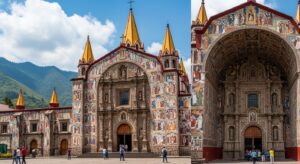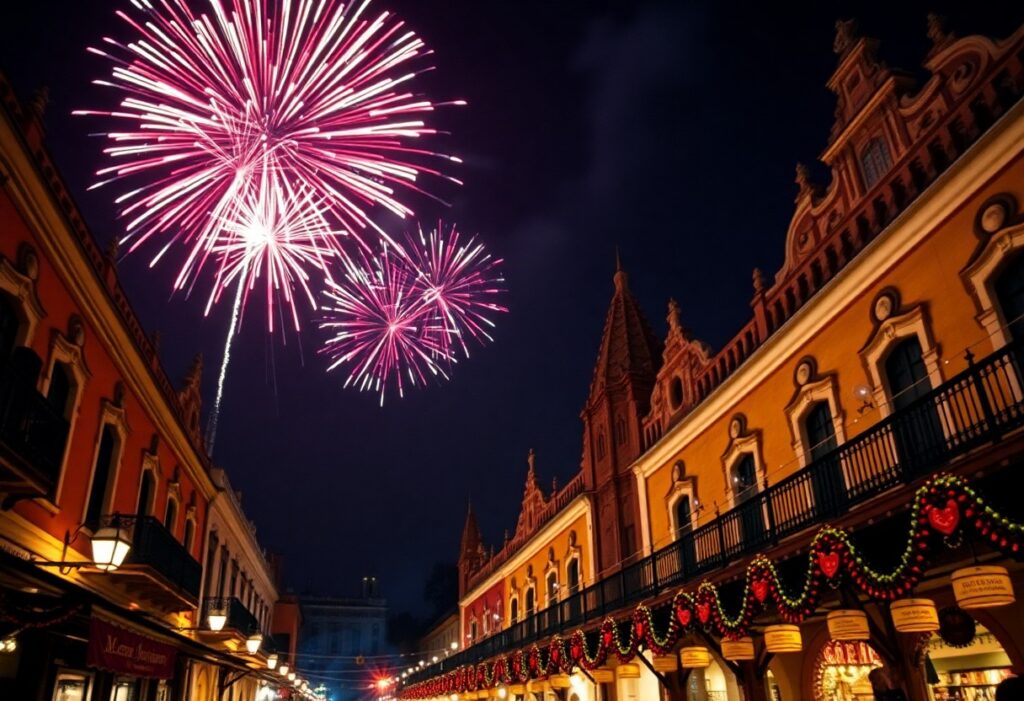With its stunning artistic treasures, El Santuario de Atotonilco stands as a must-visit destination for your journey through San Miguel de Allende. This remarkable church, adorned with vibrant frescos and baroque sculptures, serves as a pilgrimage site where thousands flock annually to seek spiritual solace and participate in solemn ceremonies. Designated as a UNESCO World Heritage Site, its rich history and cultural significance make it a key landmark that captivates visitors from across the globe.
Key Takeaways:
- El Santuario de Atotonilco is a UNESCO World Heritage Site located approximately six miles from San Miguel de Allende.
- The church features intricate frescoes by Miguel Antonio Martinez de Pocasangre, depicting scenes of blood and suffering from the life of Christ in a folk baroque style.
- The Sanctuary is a popular pilgrimage site, drawing around 100,000 visitors annually, especially for special penitence services and celebrations during Holy Week.
The Architectural Marvel of Atotonilco
The Santuario de Atotonilco stands as a testament to the creativity and spirituality of its time, exhibiting a unique architectural synthesis that captivates visitors. Built in the 18th century, its simple exterior belies the intricate artistry found within. The church’s design harmonizes indigenous motifs with Baroque elements, echoing Mexico’s rich cultural tapestry.
Design and Structure: A Blend of Traditions
This sanctuary reflects a fusion of styles, where Baroque grandeur meets local craftsmanship. The structure features thick adobe walls and an eye-catching bell tower, while its interior is adorned with vibrant frescoes that suspend reality and invite contemplation. The interplay of light and color imbues the space with an almost ethereal quality.
The Artistry of Miguel Antonio Martinez de Pocasangre
At the heart of the Santuario’s interior is the remarkable work of Miguel Antonio Martinez de Pocasangre. His frescoes, painted in the folk baroque style, are striking for their emotional depth and vivid visual narrative, often focusing on the intense and often bloody moments of Christ’s life. Each detail contributes to the church’s overarching theme of suffering and redemption.
Martinez de Pocasangre’s artistry is a blend of technique and cultural significance. His use of bold colors and dramatic figures draws you into a world where the spiritual and the earthly entwine. Many of the frescoes portray scenes of martyrdom and sacrifice, emphasizing penitence—a fitting theme for a pilgrimage site. Each brushstroke tells a story, vividly bringing to life the complex relationship between faith and suffering, making this sanctuary not just a place of worship but also a canvas of Mexico’s devotion and artistry through the centuries.
Blood and Baroque: The Artistic Narrative
El Santuario de Atotonilco embodies a breathtaking tapestry of art that narrates the profound themes of suffering, devotion, and redemption. As you walk through its vibrant interior, you’re enveloped by the emotional weight of the frescoes, which reflect a deep, almost visceral connection to the trials faced by Christ and myriad saints. The intricate layering of folk baroque elements provides a sensory overload, combining color, form, and deep religious symbolism into an overwhelming artistic experience.
Visual Themes: Suffering and Redemption
Many frescoes within the sanctuary prominently feature scenes of suffering, depicting Christ’s passion and the trials of various saints. This focus on pain serves as a reminder of the sacrifices inherent in the Christian faith. You will see images of bleeding penitents and the anguished physicality of the characters, inviting visitors to reflect on their own struggles for redemption through suffering.
The Symbolism Behind the Frescoes
The frescoes at El Santuario de Atotonilco are not merely decorative; they are steeped in rich symbolism that engages the observer’s spiritual and emotional senses. Each brushstroke and color choice conveys a narrative steeped in history, faith, and cultural nuances. Elements such as the crown of thorns and bleeding wounds emphasize sacrifice, while vibrant flowers symbolize the promise of resurrection and new life.
Within the sanctuary’s detailed frescoes, symbols vibrantly bring to life the dual themes of suffering and hope. The recurring imagery of Christ’s torturous path, intertwined with nature’s beauty, creates a profound contrast. Figures adorned in flowing robes often exhibit both agony and grace, urging you to explore the complexities of faith and suffering. Through this artistic narrative, the sanctuary becomes a canvas for personal reflection, inviting you to ponder the intricate balance of pain and redemption throughout history.

A Sanctuary of Healing and Pilgrimage
El Santuario de Atotonilco serves as both a spiritual oasis and a destination for those seeking healing. The area is historically renowned for its hot springs, which were once believed to possess therapeutic properties. This sacred site draws visitors not only for its stunning artistry but also for the promise of spiritual and physical rejuvenation amidst its hallowed walls.
The Historical Significance of Atotonilco
Atotonilco’s rich legacy is woven into Mexico’s historical fabric. The church stands as a testament to pivotal moments in the country’s fight for independence, including the marriage of Ignacio Allende and the iconic events led by Padre Hidalgo, who rallied his followers at this very sanctuary. It symbolizes the intertwining of faith and freedom, becoming a rallying point for those seeking both spiritual solace and national identity.
Rituals and Practices of Modern Pilgrims
Today, modern pilgrims engage in various rituals to express their devotion. Many visitors partake in traditional acts of penance, such as walking on their knees around the church or using self-flagellation to mirror Christ’s suffering. These practices highlight a deep commitment to spiritual purification, making each pilgrimage a profoundly personal journey. Additionally, special services and events mark the church’s calendar, attracting thousands who seek renewal within its sacred space.
The acts of modern pilgrims are a blend of physical endurance and spiritual intent. Some visitors even inflict pain on themselves, embracing the notion of suffering as a pathway to deeper faith. The use of nopal cactus bundles and hair shirts serves as a testament to their devotion, while communal services create a sense of shared experience among the faithful. The pilgrimage is not merely a physical journey but a transformative process that encourages reflection and renewal, allowing you to connect deeply with both the historical and spiritual significance of El Santuario de Atotonilco.
From Ruins to Reverence: Restoration Efforts
Restoration efforts for El Santuario de Atotonilco have transformed it from a neglected relic into a vibrant symbol of cultural pride. Years of exposure to dampness, dust, and neglect ravaged the church, leading to its inclusion on the World Monuments Fund’s list of endangered sites in 1996. The collaborative restoration project, initiated by dedicated heritage organizations and local stakeholders, has revitalized the remarkable artistry that defines the sanctuary.
The Threat of Neglect: A UNESCO World Heritage Site
Designation as a UNESCO World Heritage Site in 2008 underscored the urgent need for intervention to protect El Santuario de Atotonilco from further decay. Without timely restoration efforts, the church’s extraordinary artwork and architectural integrity faced significant threats. The combination of natural elements and human neglect risked erasing centuries of rich history from its walls.
The Role of International Support in Restoration
International support has played a pivotal role in the restoration of El Santuario de Atotonilco, driving necessary funding and expertise. Contributions from organizations like the World Monuments Fund and American Express provided critical resources for the renovation process. Their funding, alongside local allocations, has allowed skilled conservationists to conduct in-depth inspections and implement sensitive restoration methods that respect the church’s artistic heritage.
The restoration project, launched with the backing of international entities, focused on carefully analyzing the original materials and techniques used in the seventeenth-century creation of the sanctuary. Under the expert guidance of conservation teams, meticulous cleaning and restoration of murals and frescos were undertaken, ensuring the intricate details and vibrant colors shine anew. This approach not only preserved the site’s historical significance but also fostered a sense of communal identity and pride among locals and visitors alike.
The Cultural and Political Tapestry of Atotonilco
Atotonilco is not just a spiritual hub; its rich cultural and political history intertwines with Mexico’s broader narrative. This village represents the confluence of indigenous beliefs and colonial influences, as seen in its traditions, art, and the significance of the Santuario. Here, history and culture come together to form a unique identity that reflects the resilience and faith of the people.
Atotonilco’s Influence on Mexican Independence
The Santuario de Atotonilco played a pivotal role in Mexico’s fight for independence. On September 16, 1810, Padre Miguel Hidalgo rallied his followers in this very place, seizing the renowned banner of the Virgin of Guadalupe. This act of reverence transformed the church into a symbol of freedom, motivating countless Mexicans to join the struggle against colonial rule.
Contemporary Celebrations and Their Importance
Today, the Santuario hosts vibrant celebrations, particularly during Holy Week, reinforcing both faith and community. Thousands partake in ritual processions and penitential practices, honoring traditions that date back centuries. These rituals serve not only as expressions of devotion but also as unifying events for the local and broader Mexican community.
These contemporary celebrations create a tapestry of sights, sounds, and emotions that connect past and present. Rituals like the torchlit procession featuring the Our Lord of the Column highlight the enduring significance of the church as a focal point for shared identity and heritage. Each year, approximately 100,000 pilgrims come to Atotonilco, embodying a spirit of unity and unwavering faith. As you participate, you’ll find yourself woven into the fabric of a living tradition that celebrates both the sacred and the historical legacy of this remarkable site.
Ultimately
Ultimately, your visit to El Santuario de Atotonilco, known as the Sistine Chapel of the Americas, offers you a unique insight into Mexico’s rich cultural and religious heritage. This UNESCO World Heritage Site invites you to explore its stunning baroque art and experience the profound atmosphere of pilgrimage and devotion. Whether you admire the frescoes or partake in reverent traditions, Atotonilco provides a memorable journey into the heart of spirituality and history, just a short drive from San Miguel de Allende.
FAQ
What is El Santuario de Atotonilco known for?
El Santuario de Atotonilco is known for its stunning Baroque art and has been referred to as the “Sistine Chapel of the Americas.” Its interior features intricate frescoes, sculptures, and detailed murals that depict various scenes from the life of Christ, often focusing on themes of suffering and penitence.
Why is El Santuario de Atotonilco a significant pilgrimage site?
El Santuario de Atotonilco serves as a place of pilgrimage for many Mexicans, especially during special penitence services. Pilgrims often perform acts of devotion, such as walking on their knees or using flagellant whips. The church accommodates approximately 100,000 visitors annually, providing dormitories and dining facilities for those who come to seek spiritual guidance.
How can visitors reach El Santuario de Atotonilco from San Miguel de Allende?
Visitors can reach El Santuario de Atotonilco by taking the Carretera a Dolores Hidalgo road. It is about a ten-minute drive from San Miguel de Allende. Travelers should stay to the left and take the “Desviacion a Atotonilco” turnoff to arrive at the sanctuary.





El Santuario de Atotonilco resonates deeply with the intertwining of art and spirituality. The way the frescoes by Miguel Antonio Martinez de Pocasangre capture such profound emotions reminds us of the power of art to convey the human experience, transcending time and cultural boundaries. It’s fascinating how this sacred space not only serves as a pilgrimage site but also as a vibrant canvas that invites reflection and connection.
Your description of El Santuario de Atotonilco really highlights the profound intersection of art, spirituality, and community that this site embodies. I find it fascinating how places like this can serve as both stunning artistic showcases and pivotal spiritual havens for so many. The frescoes by Miguel Antonio Martinez de Pocasangre are particularly compelling; they not only communicate deep themes of suffering and redemption but also reflect the rich cultural tapestry of Mexico.
You bring up an important point about the dual nature of El Santuario de Atotonilco as both a remarkable artistic venue and a significant spiritual center. The frescoes by Miguel Antonio Martinez de Pocasangre are more than just beautiful images; they tell stories that resonate with a wide range of human experiences, from despair to hope, which is particularly relevant in today’s world.
I’m glad you found the intersection of art, spirituality, and community at El Santuario de Atotonilco so compelling. The frescoes by Miguel Antonio Martinez de Pocasangre are indeed a highlight, don’t you think? They tell stories that resonate on multiple levels, capturing not just individual struggles but the collective experience of Mexican culture.
El Santuario de Atotonilco is such a profound testament to how art and spirituality can intertwine. The intricate frescoes really pull you into the emotional depth of the scenes they depict. I’ve often found that places like this, with rich artistic heritage, have a unique way of inspiring personal reflection and connection.
As I read your post about El Santuario de Atotonilco, I was reminded of the profound connection that so often exists between art, architecture, and spiritual experience. In our fast-paced world, places like this sanctuary offer a refuge, where time seems to stand still, allowing visitors to reflect and connect with something greater than themselves. The emotional weight of the frescoes by Miguel Antonio Martinez de Pocasangre, depicting not only the trials of Christ but also the human experience of suffering and redemption, truly resonates on a personal level.
El Santuario de Atotonilco truly captures the essence of both spirituality and artistry, and your description does such justice to its significance! I had the pleasure of visiting this remarkable church a couple of years ago, and I still vividly remember the awe I felt when I stepped inside. The vibrance of the frescoes, especially those by Miguel Antonio Martinez de Pocasangre, is something that can’t be fully appreciated until you see them up close. The way the colors and intricate designs breathe life into the stories of Christ’s suffering resonates on so many levels, making the experience deeply moving.